Unlocking the Power of AI in Resource Planning
In the competitive landscape of modern project management, organizations seek solutions that not only streamline operations but also optimize resource utilization. Mosaic emerges as a formidable AI-powered resource management platform designed to revolutionize how businesses plan, allocate, and monitor their resources. This article explores how Mosaic simplifies resource planning, enhances productivity, and supports profit-driven decision-making with its comprehensive suite of intelligent features.
Centralized Data Integration for Holistic Resource Management
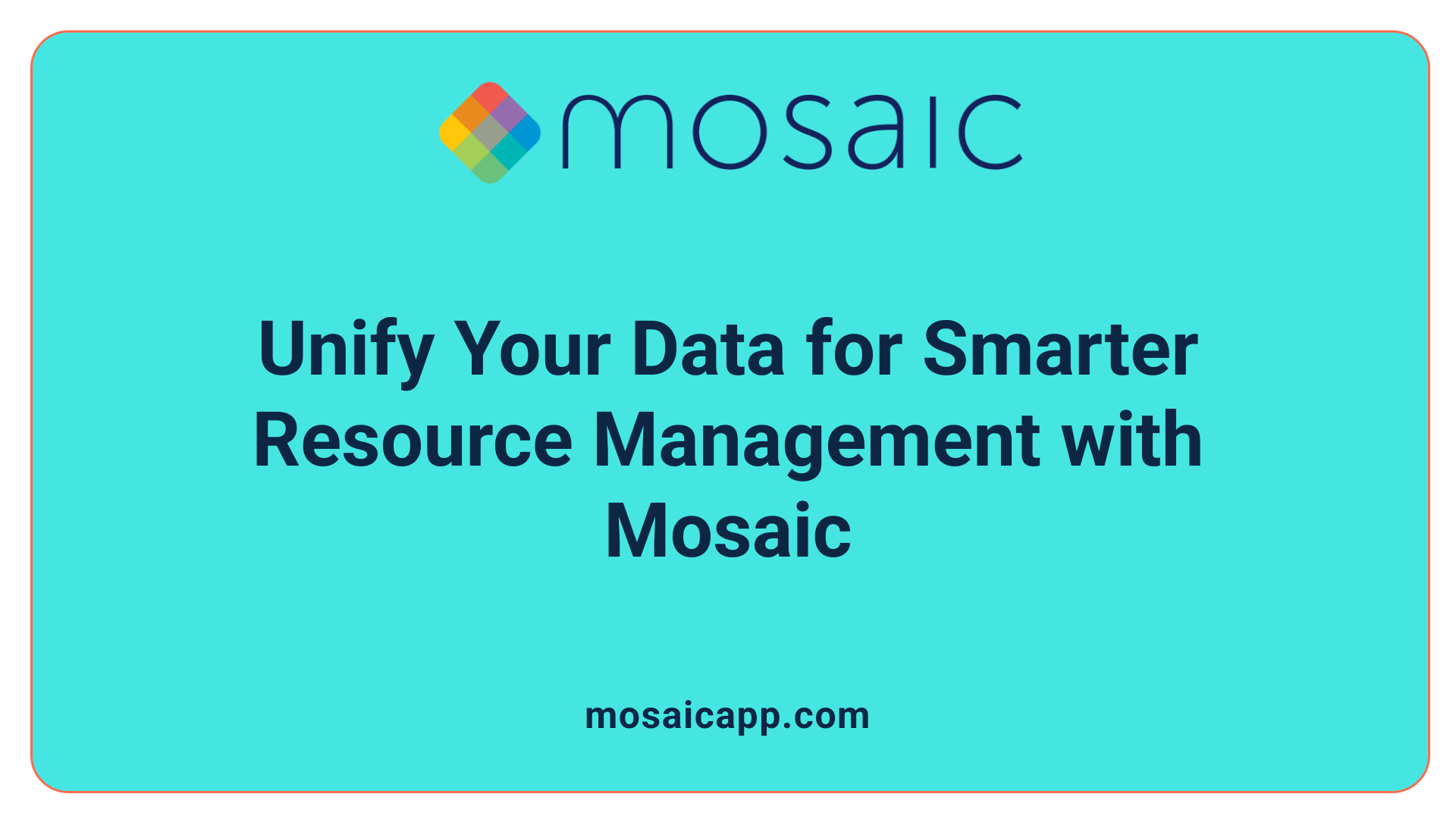
What is the benefit of centralizing data in resource management?
Centralizing data allows organizations to access comprehensive information from multiple sources in one platform. Mosaic achieves this by consolidating data from ERP, CRM, and HR systems, creating a unified workspace. This centralization simplifies project management and enables more accurate profit monitoring and task handling by removing data silos.
How does Mosaic integrate with ERP, CRM, and HR systems?
Mosaic seamlessly connects with existing enterprise software:
- ERP (Enterprise Resource Planning): Integrates financial and operational data to track budgets and resource costs.
- CRM (Customer Relationship Management): Synchronizes client and project data for better workload alignment and forecasting.
- HR Systems: Pulls employee availability and skills, aiding in resource allocation and hiring forecasts.
This integration ensures real-time updating of data, enhancing decision-making accuracy and enabling efficient resource planning.
What third-party applications does Mosaic support?
Mosaic's extensive integration capabilities include popular business applications such as:
| Application | Category | Integration Benefits |
|---|---|---|
| Hubspot | CRM | Enhances sales and project alignment |
| Jira | Project Management | Coordinates tasks and development workflows |
| Netsuite | ERP | Streamlines financial and resource data |
| Oracle | ERP | Supports large-scale enterprise resource planning |
| Procore | Construction | Aligns project data for construction management |
| Workday | HR | Syncs workforce data for capacity planning |
| Xero | Accounting | Tracks financials and budget forecasts |
By connecting with these third-party apps, Mosaic provides a flexible and scalable environment to suit diverse industry needs, from architecture to tech startups.
AI-Driven Resource Planning and Allocation Features
How Does Mosaic Support Resource Planning?
Mosaic leverages AI technology to enhance resource planning by centralizing data from ERP, CRM, and HR systems. This integration allows organizations to visualize workloads effectively and plan projects with greater accuracy. Its AI-driven resource planning capabilities enable teams to allocate tasks based on availability and capacity, reducing the risk of over-allocation and bottlenecks.
What Are the Resource Allocation Capabilities of Mosaic?
Resource allocation in Mosaic is powered by artificial intelligence that dynamically assigns tasks to team members while balancing workloads. The platform’s drag-and-drop interface simplifies workload management and ensures optimal team utilization. AI forecasts help prevent burnout by recommending workload balancing strategies.
How Does Mosaic Handle Capacity Planning?
Capacity planning is addressed through AI-powered forecasting features. By analyzing historical data and current workload, Mosaic predicts future capacity needs and provides real-time insights into resource availability. This helps project managers allocate resources efficiently and avoid overextension.
In What Ways Does Mosaic Help with Hiring Forecasts?
Mosaic’s hiring forecast tool uses AI to analyze resource demands and predict when additional hiring may be necessary. By identifying potential staffing gaps ahead of time, organizations can plan recruitment efforts proactively, ensuring projects maintain momentum without delays.
Together, these AI-driven features make Mosaic a comprehensive solution for ensuring that teams are effectively planned, allocated, and prepared to meet organizational goals with agility and foresight.
Enhancing Financial Oversight with Real-Time Budget Tracking
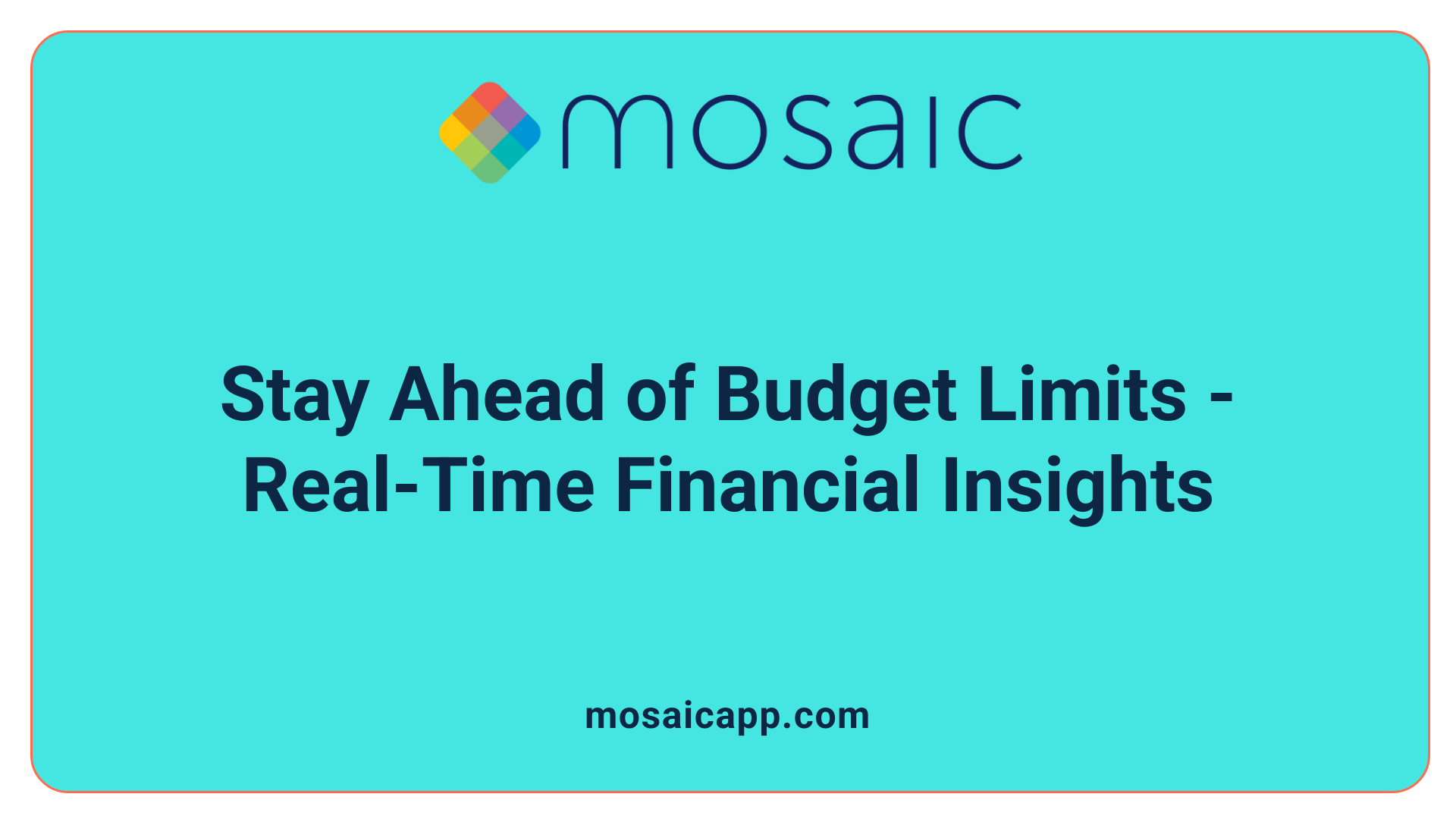
How does Mosaic improve budget tracking and financial visibility?
Mosaic enhances financial oversight by providing real-time budget tracking capabilities that allow project managers to continuously monitor project expenditures. This dynamic visibility means budgets are actively updated as projects progress, enabling early detection of any potential overruns.
The platform centralizes financial data from various sources, including ERP and CRM systems, creating a comprehensive financial snapshot. This integration simplifies the process of tracking labor costs and other expenses, streamlining financial management and reducing manual errors.
In what ways does Mosaic support labor cost monitoring and resource adjustments?
Labor costs often represent a significant portion of project expenses. Mosaic's real-time tracking enables project managers to closely supervise labor expenditures and assess if current resource allocations align with budget constraints.
With AI-driven resource allocation tools, managers can make informed adjustments to staffing levels or redistribute workloads to maintain cost effectiveness. This proactive approach helps prevent budget overruns while optimizing team utilization and avoiding burnout.
What benefits arise from using Mosaic's financial visibility features?
- Accurate Budget Control: Continuous updates allow for immediate attention to deviations, promoting disciplined spending.
- Data-Driven Decisions: Financial insights empower project teams to allocate resources more effectively and forecast expenses reliably.
- Enhanced Profit Monitoring: Integrating financial tracking with project management supports identifying profitable projects and areas needing improvement.
Overall, Mosaic's real-time budget tracking and financial visibility tools provide a solid foundation for managing costs and enhancing financial performance throughout a project's lifecycle.
Workforce Intelligence and Team Performance Analytics
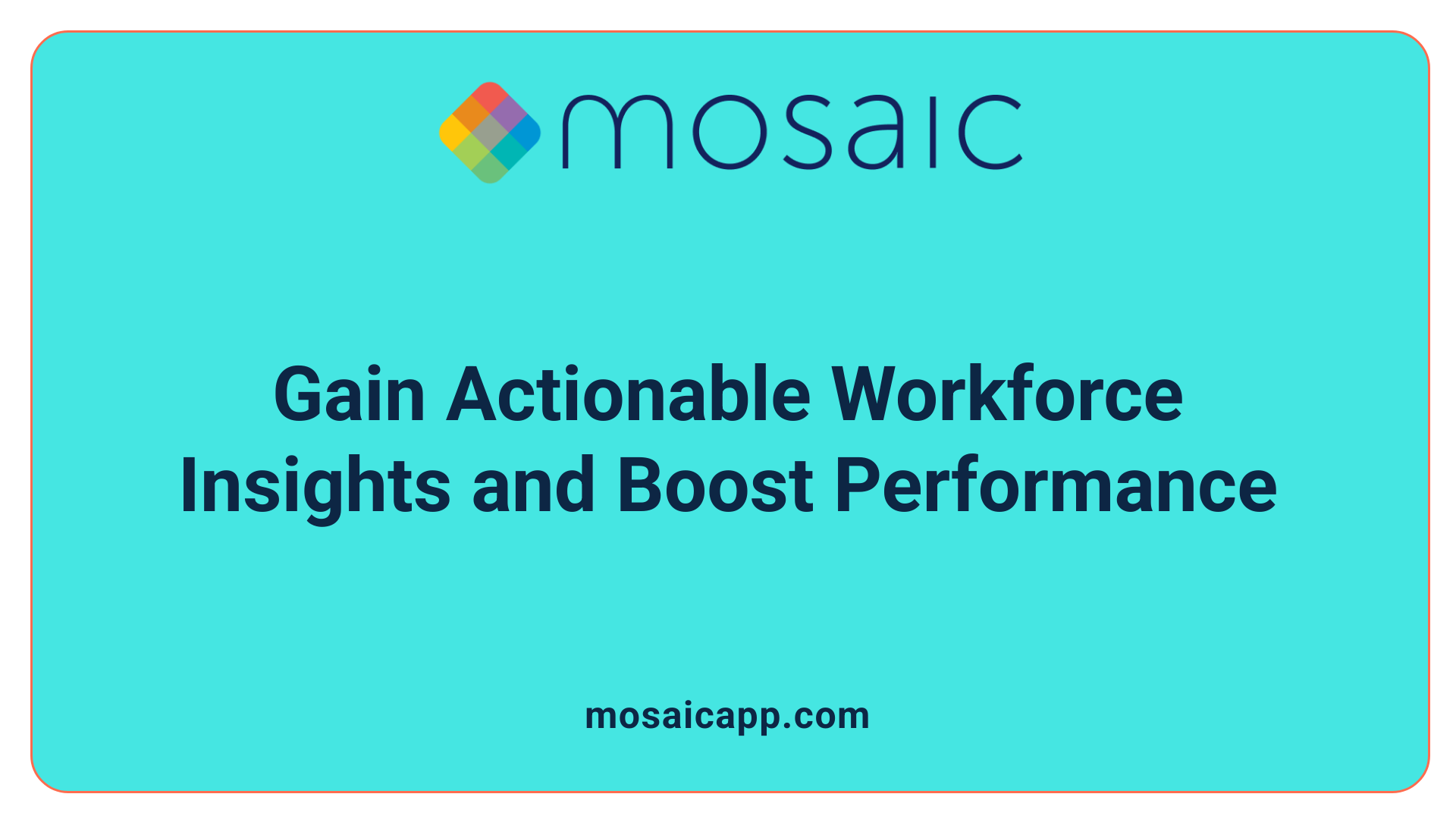
How Does Mosaic Utilize KPI Dashboards to Enhance Workforce Intelligence?
Mosaic integrates KPI dashboards that provide project managers and team leaders with immediate visibility into critical performance indicators. These dashboards display real-time data on team productivity, resource utilization, and project progress. By centralizing this information in a user-friendly interface, Mosaic empowers decision-makers to swiftly identify performance trends and operational bottlenecks.
What Role Do Variance Reports Play in Monitoring Team Performance?
Variance reports in Mosaic analyze discrepancies between planned and actual resource allocation, timelines, and budget consumption. They highlight deviations in workload or costs, enabling managers to pinpoint areas where projects are off track. This insight supports timely corrective actions and helps maintain alignment with overall project goals.
How Does Mosaic Support Profit-Driven Planning Through Workforce Analytics?
Mosaic leverages workforce intelligence to drive profit-focused strategies by linking team performance metrics directly to financial outcomes. By monitoring labor costs against project budgets and performance KPIs, organizations can optimize resource allocation to maximize profitability. The platform’s AI-powered analytics facilitate forecasts that help balance workload, reduce inefficiencies, and improve project delivery within budget constraints.
Together, these features create a comprehensive framework for data-driven workforce management. Mosaic’s workforce intelligence capabilities ensure teams remain productive, projects stay financially sound, and organizational goals align with resource deployment strategies.
Streamlining Project Planning with Customizable Templates
How Does Mosaic Facilitate Project Planning?
Mosaic offers comprehensive project planning tools that help teams organize and monitor their workload efficiently. At its core, Mosaic enables users to map out project timelines, allocate resources, and track tasks with an intuitive drag-and-drop interface. This simplification supports collaboration and ensures everyone stays aligned on project goals and deadlines.
What Are Recurring Project Templates in Mosaic?
A standout feature of Mosaic's planning capabilities is its customizable templates specifically designed for recurring projects. These templates allow users to standardize routine workflows, reducing the time spent on setting up new projects each time similar work arises. By tailoring templates to fit specific project types or organizational needs, teams can quickly initiate projects with predefined scopes and schedules.
How Does Mosaic Support Timely Delivery?
By leveraging these customizable templates alongside real-time workload visibility and AI-driven resource allocation, Mosaic helps ensure projects stay on track. Users benefit from timely alerts and workload balancing that prevent bottlenecks and over-allocations. This proactive approach allows managers and team members to make adjustments before delays occur, supporting consistent on-time delivery.
In What Ways Does Mosaic Assist with Budget Management?
Mosaic integrates budget forecasting and real-time financial tracking into its project planning suite. Its tools enable project managers to monitor labor costs and overall budget adherence continuously. This financial visibility lets teams adjust resource allocation promptly to avoid overspending, while AI-driven budget forecasts provide insights into future financial impacts. Consequently, Mosaic ensures projects are not only delivered on time but also within budget constraints.
Optimizing Resource Utilization to Prevent Burnout
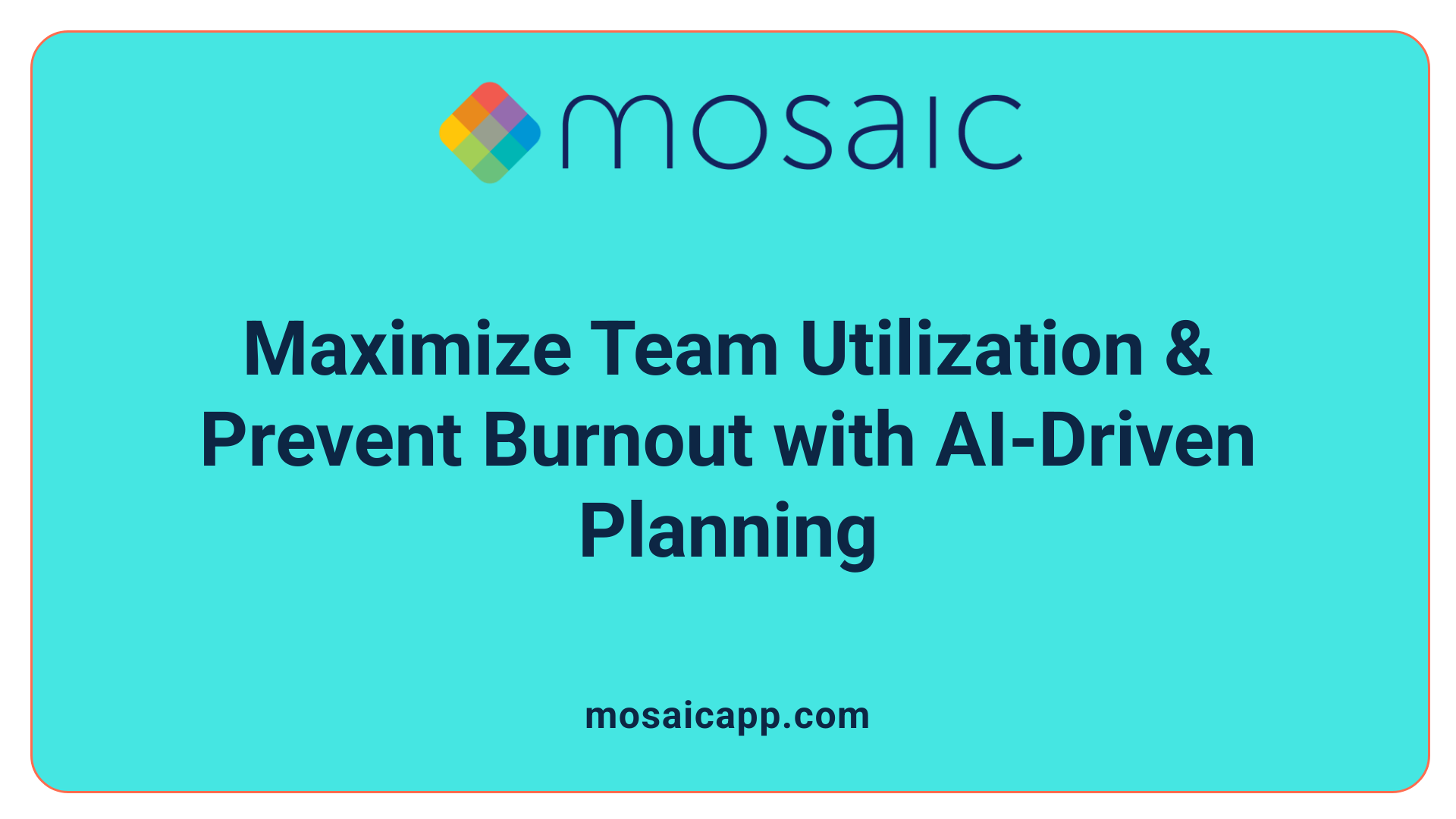
How does Mosaic use AI for resource optimization?
Mosaic leverages AI-powered forecasting and resource allocation to enhance resource optimization. This capability allows the platform to predict project demands and team capacity accurately, ensuring resources are efficiently distributed. By analyzing workload trends and upcoming project needs, Mosaic helps organizations make informed decisions that maintain a balanced allocation of tasks.
How does Mosaic help maximize team utilization?
Effective team utilization is a core focus within Mosaic's resource management tools. The platform provides workload visibility and balancing features that help managers assign tasks according to each team member's availability and capacity. This prevents overloading individuals while maximizing productive use of all team resources.
In what ways does AI forecasting in Mosaic aid in preventing burnout?
Through AI forecasting, Mosaic anticipates potential bottlenecks and workload spikes before they occur. This proactive approach to resource planning allows managers to adjust assignments or hire additional support timely. By avoiding excessive work demands on individual team members, the software plays a crucial role in preventing burnout and maintaining overall workforce well-being.
Mosaic's intelligent resource optimization tools combine predictive analytics with real-time data to streamline workflows. This results in teams that are efficiently utilized without being overworked, enabling organizations to deliver projects on time and within budget while fostering a sustainable work environment.
Seamless Integration with Popular Business Applications
How Does Mosaic Integrate with Other Business Applications?
Mosaic enhances its resource management capabilities by seamlessly integrating with a variety of widely-used third-party business applications. This ensures that organizations can unify their data and workflows across multiple platforms for smoother project execution.
Which Business Applications Does Mosaic Support?
Mosaic supports integration with several key software solutions including:
- Hubspot: Strengthens customer relationship management by syncing sales and marketing data with resource planning.
- Jira: Bridges project tracking and issue management with resource allocation for agile teams.
- Netsuite: Connects enterprise resource planning data, including financials, to improve budget forecasting and profitability insights.
- Oracle: Links robust enterprise data for comprehensive resource and financial planning.
- Procore: Integrates construction project management details to streamline task scheduling and resource deployment.
- Workday: Combine HR information with workload and capacity planning to optimize team utilization.
- Xero: Syncs accounting and financial data to enable real-time budget tracking and cost monitoring.
Why Are These Integrations Important?
By connecting with these popular tools, Mosaic centralizes critical project, financial, HR, and CRM data. This unified data approach enhances decision-making through real-time insights, simplifies cross-functional collaboration, and reduces manual data entry errors.
These integrations enable project managers and teams to plan workload and resources more effectively, forecast hiring needs accurately, and monitor profit margins closely, all within a single platform.
Overall, Mosaic’s extensive integration capabilities make it adaptable across industries such as architecture, construction, creative agencies, marketing departments, and tech startups, supporting varied project and organizational needs with a connected, data-driven workflow.
Industry Applications: From Architecture to Software Development
How does Mosaic serve architectural firms?
Mosaic enhances project management in architectural firms by providing customizable templates for recurring projects, which helps ensure timely delivery within budget. Its AI-powered resource planning and allocation assist architects in balancing workloads while optimizing team utilization to prevent burnout. Additionally, real-time budget tracking offers financial visibility critical in managing project labor costs.
What benefits does Mosaic offer to the construction industry?
In construction, Mosaic integrates data from various systems, such as ERP and CRM, centralizing information for seamless project oversight. Features like capacity planning and hiring forecasts enable construction managers to anticipate workforce needs. The platform's integration with software like Procore and Oracle also aligns well with workflow requirements in construction projects.
How is Mosaic applicable to creative agencies?
Creative agencies benefit from Mosaic's AI-driven resource optimization and workload visibility. Its user-friendly interface with drag-and-drop task assignments simplifies team collaboration and project planning. Agencies can monitor key performance indicators using workforce intelligence dashboards, supporting profit-driven project management.
In what ways does Mosaic support software startups?
For tech startups, Mosaic provides tools for precise resource allocation and scheduling, crucial for agile and collaborative environments. Built-in time tracking and reporting help startups maintain transparency and optimize productivity. Integration capabilities with tools like Jira enhance project tracking, while AI features assist in forecasting and managing workloads efficiently.
| Industry Sector | Mosaic Features Utilized | Benefits Provided |
|---|---|---|
| Architectural Firms | Customizable project templates, budget tracking, AI resource optimization | On-time, budget-friendly project delivery, efficient workload balance |
| Construction | Data centralization, integration with Procore and Oracle, capacity planning | Anticipated workforce needs, streamlined project management |
| Creative Agencies | AI-driven resource allocation, KPI dashboards, intuitive task management | Simplified collaboration, profit-focused planning |
| Software Startups | Time tracking, Jira integration, AI workload forecasting | Enhanced productivity, agile resource scheduling |
User-Friendly Interface Facilitating Intuitive Project Management
Drag-and-Drop Task Assignments
Mosaic's interface is designed with user experience at the forefront, offering a drag-and-drop task assignment feature that simplifies how project managers allocate work. This intuitive design reduces the time required to assign tasks and adjust workloads, contributing to smoother workflow management.
Workload Visibility
The platform provides clear workload visibility, enabling project managers and team members to see who is assigned to what and how much work each person has. This transparency helps identify potential over-allocations early and supports balanced resource distribution to avoid burnout.
User Experience Design
Mosaic boasts an intuitive interface that is easy to navigate, even for users who are new to resource management software. Its user-friendly design minimizes learning curves and improves adoption rates across teams, ensuring that collaboration and project planning are streamlined right from the start. The clean layout and straightforward tools allow users to focus on managing projects efficiently without getting bogged down by complexity.
Core Functionalities: Task Management, Time Tracking, and Reporting
How does Mosaic handle task creation and tracking?
Mosaic provides an intuitive platform for creating and tracking tasks, catering to project requirements across industries such as creative agencies, software development, and marketing. Users can easily assign tasks using drag-and-drop features, making task management straightforward and efficient. This flexibility ensures that teams can monitor progress and deadlines effectively, supporting timely project delivery.
What built-in time tracking features does Mosaic offer?
The platform includes built-in time tracking capabilities to record the time spent on various tasks and projects. This allows teams to monitor their workload accurately and supports real-time budget tracking by capturing labor costs dynamically. Time tracking data also feeds into workforce intelligence, helping managers identify utilization patterns and adjust resources to avoid burnout.
How robust are Mosaic's reporting capabilities?
Mosaic equips organizations with advanced reporting features, including customizable KPI dashboards and variance reports. These tools provide deep insights into team performance, project progress, and financial health. Reporting supports profit-driven planning and gives project managers clear visibility into timelines, resource allocation, and budget adherence to make data-driven decisions.
Together, these core functionalities enable Mosaic to streamline project planning and enhance workflow efficiency through seamless task management, precise time tracking, and insightful reporting.
Pricing and Trial Options for Flexible Adoption
What is the pricing structure of Mosaic?
Mosaic offers a straightforward pricing model starting at $9.99 per user per month. This tiered approach allows organizations of various sizes, from small creative agencies to larger tech startups, to scale their subscription according to their team size and project demands.
Is there a free trial available?
Yes, Mosaic provides a 30-day free trial period. This trial option enables potential users to explore the platform’s features risk-free, including its AI-powered resource planning, real-time budget tracking, and workload visualization capabilities.
How does Mosaic provide value for money?
Mosaic is evaluated positively across features, ease of use, onboarding, customer support, and overall user reviews. Through its comprehensive functionality—such as customizable project templates, AI-driven hiring forecasts, and seamless integrations with tools like Jira and Hubspot—Mosaic helps teams optimize resource allocation and improve operational efficiency. Users benefit from enhanced collaboration and data-driven decision-making, ensuring projects stay within budget and on schedule, which ultimately delivers substantial return on investment.
Addressing Common Resource Management Challenges with AI
How Does Mosaic Tackle Overallocation?
Overallocation occurs when team members are assigned more work than they can handle, leading to burnout and reduced productivity. Mosaic’s AI-powered resource allocation and forecasting features actively prevent overloading by analyzing team availability and workload in real time. The platform reallocates tasks dynamically to balance workloads, ensuring no individual is overwhelmed.
How Does Mosaic Resolve Prioritization Conflicts?
Prioritization conflicts often arise when tasks compete for the same resources. Mosaic’s project planning tools with customizable templates help managers set clear priorities based on project deadlines and budgets. Its AI-driven insights guide resource allocation to focus on high-impact tasks first, reducing delays and improving project delivery.
What Solutions Does Mosaic Provide for Dependency Management?
Managing task dependencies can be complex and risk project bottlenecks. Mosaic’s integrated timelines and project mapping visualize dependencies, helping teams spot conflicts early. Additionally, AI algorithms forecast schedule impacts of resource shifts and automatically adjust plans to maintain smooth workflows, minimizing the risk of delays due to dependency issues.
By combining real-time data centralization and AI intelligence, Mosaic empowers organizations to proactively manage common resource challenges, ultimately improving efficiency and ensuring successful project outcomes.
Automation Enhancing Efficiency in Workflow and Alerts
How does automation improve workflow efficiency in Mosaic?
Mosaic leverages automation to streamline resource management and project planning processes. By using AI-driven functionalities, it automatically reallocates tasks based on team member availability and workload. This dynamic task reallocation minimizes over-allocation and optimizes team utilization, helping prevent burnout and ensuring balanced workloads. Automation eliminates manual adjustments and speeds up decision-making, which keeps projects on track and within budget.
What role does task reallocation play in Mosaic's automation features?
Task reallocation in Mosaic is powered by AI that continuously monitors project demands and team capacity. When unexpected changes occur—such as a team member becoming unavailable or project priorities shifting—the platform instantly adjusts assignments. These automatic reallocations ensure that no resource remains underutilized or overburdened. The drag-and-drop interface also works seamlessly with this automation, allowing managers to manually fine-tune allocations effortlessly.
How does Mosaic's alert system support project management?
Mosaic includes smart alert functionalities designed to notify managers and team members about critical updates. Alerts can be triggered for budget overruns, nearing deadlines, resource shortages, or workload imbalances. These real-time notifications provide early warnings that prompt timely interventions. By keeping stakeholders informed, the alert system enhances transparency, reduces risks, and supports proactive project adjustments.
Together, these automation tools help Mosaic users optimize workflows, increase productivity, and maintain control over complex projects with ease.
Effective Resource Planning Techniques Deployed in Mosaic
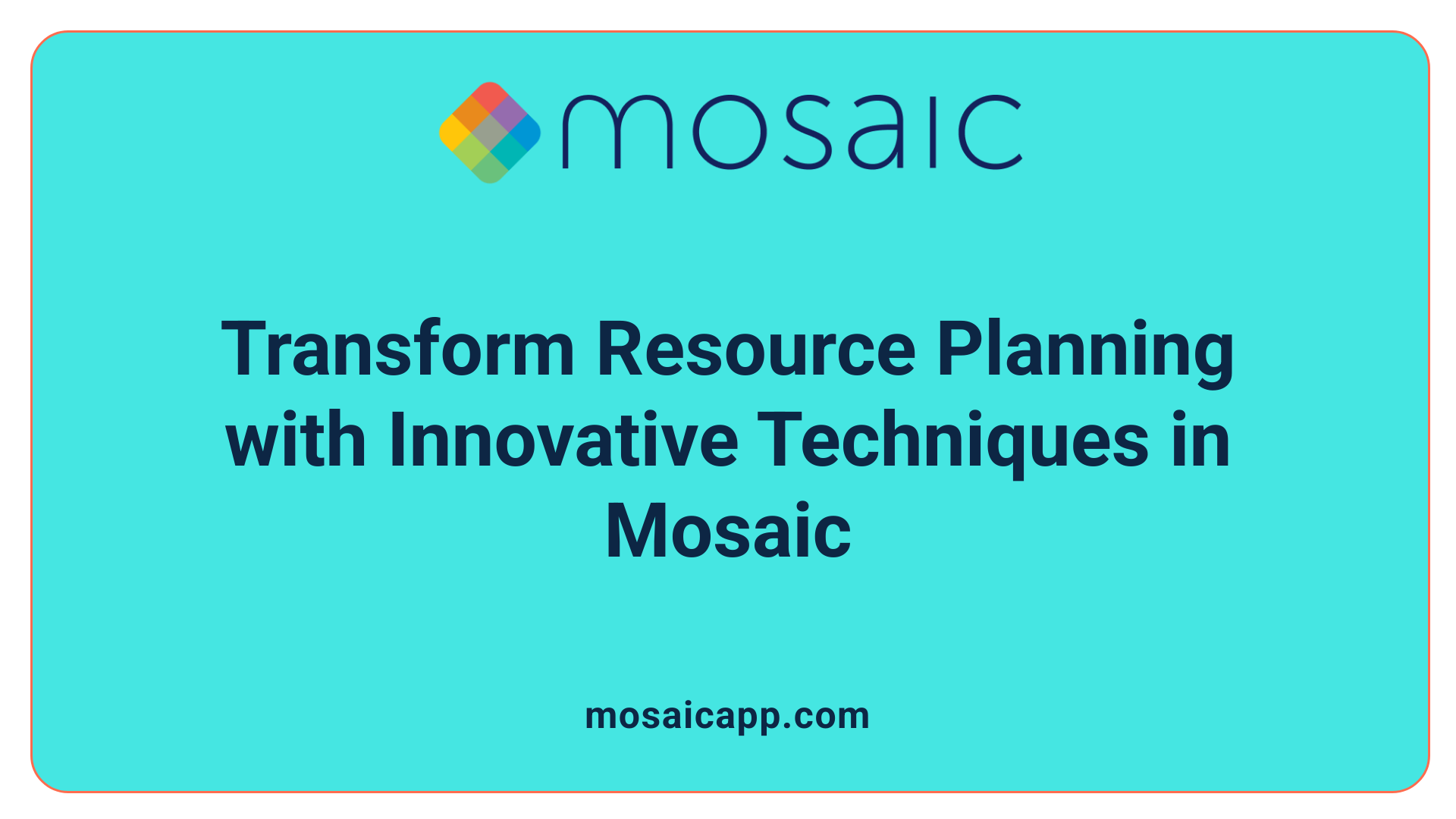
How Does Mosaic Utilize Resource Leveling?
Resource leveling in Mosaic addresses over-allocation by balancing team member workloads against their availability. The platform's AI-driven resource allocation automatically redistributes tasks when conflicts or bottlenecks arise, ensuring no individual is overwhelmed.
What Role Does Resource Smoothing Play in Mosaic?
Mosaic employs resource smoothing techniques to maintain a consistent workload flow without altering project deadlines. This method helps avoid peak workload periods that could cause burnout and ensures smoother task transitions across teams.
How Does Mosaic Optimize Workloads Effectively?
Through AI-powered forecasting and real-time workload visibility, Mosaic allows managers to predict resource needs in advance and adjust assignments accordingly. This dynamic approach prevents bottlenecks, maximizes utilization, and supports timely project delivery within budget constraints.
Mosaic's integration of these planning techniques enables organizations in industries like architecture, construction, and creative agencies to achieve efficient resource management. Its combination of workload balancing, AI forecasting, and customizable project templates facilitates smoother operations and enhances both team productivity and project outcomes.
Collaborative Tools Promoting Team Communication and Transparency
How Does Mosaic Facilitate Collaboration?
Mosaic enhances team communication with an intuitive interface that supports streamlined project planning and workload visibility. Its drag-and-drop task assignments enable easy delegation and quick adjustments, encouraging seamless collaboration among team members.
The platform centralizes data from ERP, CRM, and HR systems, ensuring that everyone works from consistent information sources. Built-in time tracking and task monitoring features further support transparent workflows by keeping all stakeholders informed about real-time progress and individual contributions.
Can Users Customize Dashboards for Better Insight?
Yes, Mosaic offers customizable KPIs and reporting dashboards that help users tailor information to their project’s needs. This flexibility allows project managers to focus on performance indicators most relevant to their teams and business objectives.
Dashboards provide visibility into workforce intelligence metrics such as capacity planning, variance reports, and profit monitoring, enabling data-driven decision making. Custom templates for recurring projects also contribute to clarity and consistency in project execution.
What Role Does Data Analytics Play in Mosaic’s Collaboration?
Data analytics is a core feature embedded in Mosaic’s workforce intelligence tools. It analyzes team performance through KPI dashboards and variance reports, empowering managers to identify bottlenecks and proactively adjust resources.
The AI-powered forecasting and resource allocation algorithms utilize historical and current data to optimize utilization and prevent burnout. Real-time budget tracking and financial visibility offered by the platform allow teams to align resources and expenditures efficiently, promoting financial transparency in collaborative projects.
| Feature | Description | Benefit |
|---|---|---|
| Drag-and-drop Task Assignment | Simplifies assigning and adjusting tasks within teams | Enhances ease of collaboration and flexibility |
| Customizable Dashboards | Tailors KPI views and reports to project specifics | Provides targeted insights and performance monitoring |
| Workforce Intelligence | Uses analytics for performance and budget tracking | Supports informed, profit-driven decisions |
Positioning Mosaic Among Top Resource Management Tools in 2025
How Does Mosaic Compare to monday.com?
Mosaic and monday.com both serve as comprehensive resource management platforms but cater to slightly different user needs. While monday.com offers versatile work management features adaptable across various industries, Mosaic focuses more specifically on AI-powered resource planning and financial visibility. Mosaic's integration of ERP, CRM, and HR data sources strengthens its project financial control capabilities, making it particularly suitable for profit-driven project tracking. On the other hand, monday.com emphasizes customizable workflows and broad collaboration tools, which appeal to teams seeking flexible project management beyond just resource allocation.
What Are the Differences Between Mosaic and nTask?
nTask focuses heavily on task and issue management with simple resource tracking, ideal for small to medium businesses needing straightforward project coordination. Mosaic goes further in utilizing AI for dynamic resource allocation, hiring forecasts, and capacity planning, offering advanced workload balancing and burnout prevention. nTask provides essential project planning but lacks Mosaic's depth in financial oversight and real-time budget tracking, positioning Mosaic as better for teams where financial accuracy and resource optimization are critical.
How Does Mosaic Stand Against Resource Guru?
Resource Guru specializes in straightforward resource scheduling, providing a clean interface for managing team availability and booking. Mosaic matches these scheduling features with richer AI-driven forecasting and comprehensive budget management. Additionally, Mosaic's workforce intelligence tools, including KPI dashboards and variance reports, offer stronger analytics for improving team productivity and profitability compared to Resource Guru’s focus primarily on calendar-based resource allocation.
Comparing Mosaic to Epicflow
Epicflow targets medium to large organizations with multi-project portfolio management and AI-powered predictions to tackle complex enterprise environments. It combines resource and project portfolio management with automated planning and bottleneck detection, suited for industries like aerospace and defense. Mosaic, while also leveraging AI, is more oriented towards industries such as architecture, creative agencies, and software development, offering a balance between ease of use and advanced financial and workforce analytics. Unlike Epicflow's strong enterprise focus, Mosaic’s accessible pricing and intuitive design make it attractive for small to mid-sized organizations seeking AI-enhanced resource management without the complexity of large portfolio tools.
Conclusion: Embracing Data-Driven Resource Planning for Project Success
Mosaic stands out as a comprehensive, AI-powered resource management platform that addresses critical challenges in project planning and execution. Its integration capabilities, user-friendly interface, and advanced analytics empower organizations to optimize resource allocation, maintain financial control, and enhance team performance. As industries evolve, embracing tools like Mosaic that offer automation, real-time insights, and collaboration will be key to achieving efficiency and sustaining competitive advantage.


